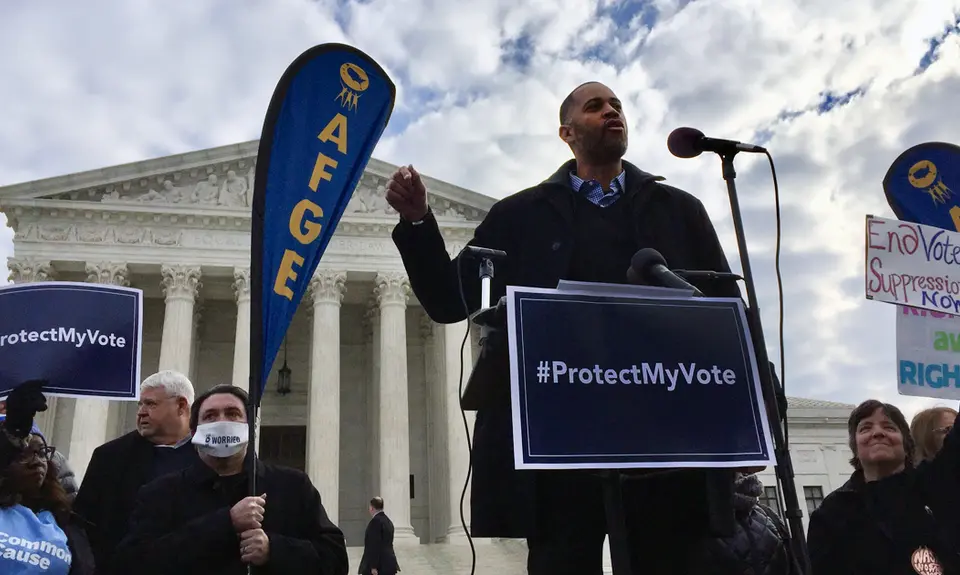One of the most common and least visible forms of voter suppression is the removal of eligible voters from the rolls if they haven’t voted recently. The victims only find out when they go to vote and are told they can’t, because they’re no longer registered. Through the 1993 “Motor Voter” law and the 2002 Help America Vote Act, Congress made it easier for Americans to register to vote, and prohibited states from striking them from the rolls just because they have not actually voted.
On January 10, the Supreme Court heard oral arguments in Husted v. A. Philip Randolph Institute, a case challenging an Ohio purge process triggered solely by a citizen not voting during a single two-year federal election cycle. Local election boards identify people who have not voted in two years, then send them confirmation notices to see if they still live at their registered addresses. If the registered voter doesn’t respond or vote within the next four years, their name will be purged. And if you happen not to see the notice among the junk mail, or if it doesn’t arrive for some reason, you’re out of luck.
The disenfranchisement process is set in motion by only one thing: not voting. The New York Times reported on the oral argument:
Justice Sonia Sotomayor said Ohio’s approach effectively disenfranchised minority voters in the state’s major cities and were part of a broader effort to suppress voting.
“All of these impediments result in large numbers of people not voting in certain parts of the state,” she said.
But Justices Anthony M. Kennedy and Stephen G. Breyer expressed concern about maintaining the integrity of the state’s list of eligible voters.
“They want to protect the voter rolls from people who have moved and are voting in the wrong district,” Justice Kennedy said.
But as a 2016 Reuters study revealed:
In the state’s three largest counties that include Cleveland, Cincinnati and Columbus, voters have been struck from the rolls in Democratic-leaning neighborhoods at roughly twice the rate as in Republican neighborhoods.
That’s because residents of relatively affluent Republican-leaning neighborhoods are more likely to vote in both congressional elections and presidential contests, historical turnouts show. Democrats are less likely to vote in mid-term elections and thus are more at risk of falling off the rolls.
At the circuit level, the United States agreed with the challengers that Ohio’s voter purge process violates federal law because it is triggered solely by a citizen not voting. But that was before the election. Under Jeff Sessions, the Department of Justice switched sides in the case under circumstances that are not entirely clear. As Justice Sotomayor noted to the Solicitor General, it is “quite unusual that your office would change its position so dramatically.” Indeed, as reported by Salon:
The move is so unusual that [PFAW Foundation affiliate] People for the American Way submitted a Freedom of Information Act request for communications between Ohio State Solicitor Eric Murphy and John Gore, acting director of the civil rights division at the Justice Department. Gore — like many Trump appointees — had worked previously at the Jones Day law firm, where he spent much of his time on cases aimed at undermining voting rights. Murphy worked for the same firm when Gore was working there.
The fact that these were "two old colleagues from the same firm, that unfortunately has been involved a lot in negative actions with respect to voting," communicating with each other seemed highly relevant, Elliot Mincberg, a senior fellow at People for the American Way, told Salon.
The emails have a chummy tone, but provide little information on whether Murphy pressured Gore to change the Justice Department's position. There are requests for phone calls, but what was discussed on those calls remains unknown. At one point, Gore mentions that he "ran into" a mutual acquaintance who "mentioned this case," but the name of that person is redacted.
“We’re disappointed that there’s still a lot that we don’t know, like the identity of that mysterious person that apparently Mr. Gore saw sometime early and talked to about the case, and what other communications there may well have been," Mincberg said, adding that PFAW still hopes to learn more of those details.
The Supreme Court will issue its ruling by the end of its term in late June, just a few months before the 2018 midterm elections. Whether all Ohio citizens will be allowed to exercise their right to vote in November is up to the nine justices.
